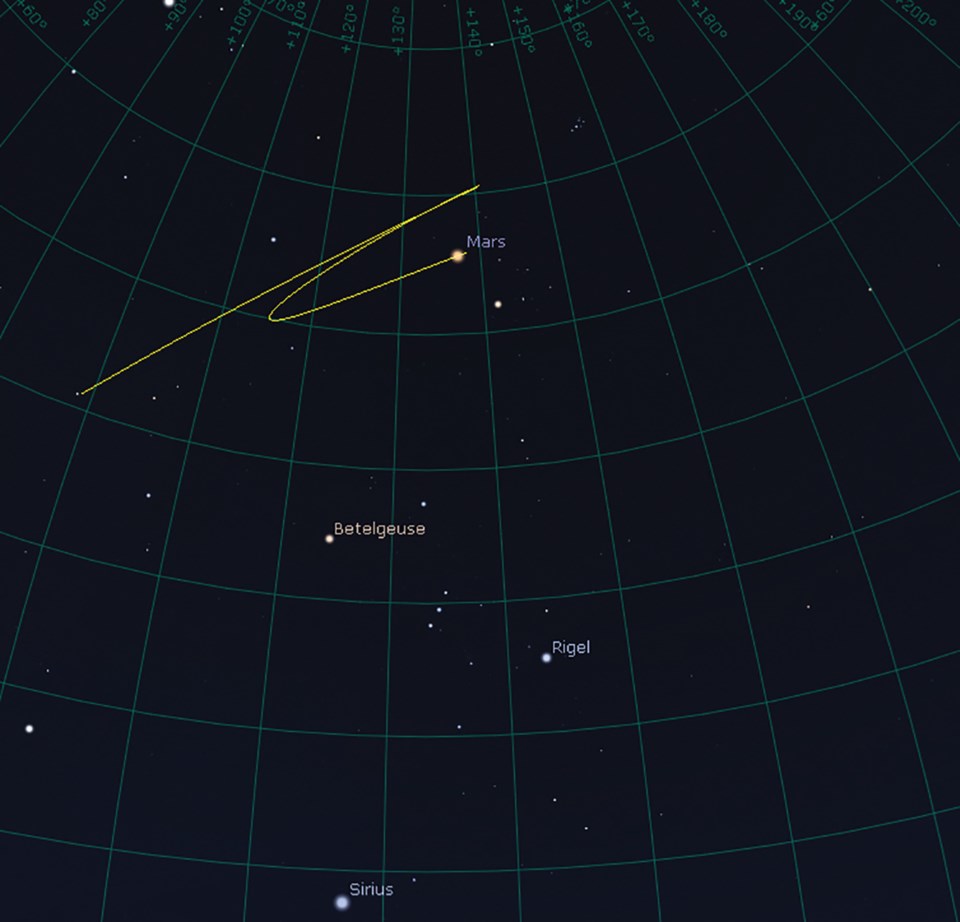Mars continues to brighten every night in October. It begins the month rising in the ENE just before midnight and just left of the bright star Aldebaran in Taurus. Last month it started out above Aldebaran but has moved east along the ecliptic and while Aldebaran is 0.85 magnitude, Mars is now brighter and redder at -0.59 magnitude. Mars has been moving in a prograde direction (eastward) through the sky but this ends on Oct. 30 with Mars about 15 degrees east of Aldebaran and almost due north of Betelgeuse, the bright pink star at the top left of Orion. The three objects will make a pretty triangle, two pinkish stars and a brighter, redder Mars. By that point it will have brightened to magnitude -1.2. We will have almost caught up with Mars and our own faster motion will make Mars appear to move retrograde (westward) through the stars. It just keeps getting better through November before its Dec. 7 opposition. The Stellarium screenshot shows the position of Mars in the sky from Oct. 1 through the end of March 2023. If anyone has kids who would like a challenge, convince them to get up at 0500 each clear morning and take a cellphone picture of Orion in the south before sunrise. The resultant series of pictures will clearly show Mars’s motion against the stars.
Jupiter was at opposition in late September and is therefore about as big and bright as it gets. On the night of Oct. 3/4, all four big moons will be lined up east (left) of Jupiter and in their order of distance from the planet: Io closest, then Europa, Ganymede and Callisto farthest east. Two weeks later on the night of Oct. 17/18, they do it again although it will be tough to distinguish all four moons. That night Io and Europa start very close together and Ganymede and Callisto are no more than one minute of arc apart; that’s one-thirtieth of the diameter of our moon.
Next is Saturn, well past its opposition in mid-August. While I’ve viewed Saturn a number of times through telescopes – and it’s awesome – I don’t usually use binoculars on it because I can never see the rings. I did read recently, however, that it’s possible to see its big moon Titan with binoculars. Since I recently acquired a pair of 15 x 70 binocs, I’ll have to try to see it, since Titan at its maximum elongation is about four ring diameters away from the planet. According to Stellarium, Titan is at maximum elongation from Saturn around Oct. 4 and it takes about a week to do half an orbit out to its other extreme. I’ll let you know if I succeed.
Another interesting event should be visible in the evening of Oct.11. The moon, just past full, rises about 1930 in the ENE and will be about 20 degrees above the horizon and nearly due east by 2140. Look just about one moon width to the left at about the 8 o’clock position. If the sky is clear and dark and your eyesight is good enough, you may be able to spot a very faint star. The moon, meanwhile is moving down and to the left (east) relative to the stars and by 2208 that star will be right at the lower left limb of the Moon and will be quickly occulted. About an hour later it will reappear from behind the Moon at 2311. Since the right limb of the Moon will be in shadow, that faint star will blink into view quickly. Except that the “star” is actually the planet Uranus. By all means, use binoculars if you have them since Uranus is right at the limit of naked-eye visibility. Incidentally, I have never spotted Uranus in 40 years of observing, mainly because my scope is strictly manual and my setting circles aren’t accurate enough and I’ve never noticed it near enough to something I can find. Spotting it on Oct. 11 should be a cinch, however. Even in telescopes larger than my eight inch, Uranus is just a tiny blue-green disc. Its moons are beyond my scope’s capabilities as well. Interestingly, if you miss it in October you might catch it again on Nov. 8 at about 0610 when the moon is setting in the west. No occultation this time but a very close pass just to the north of Uranus.
The October club meeting open to the public will be Oct.14 at the Sechelt Library at 7:30 p.m. with the lecture topic being “Why I love Globular Clusters” by Peter Jedicke. Globular clusters are tightly packed spheres of hundreds of thousands to millions of stars, that orbit our galaxy.
Please check the Sunshine Coast Club website at https://sunshinecoastastronomy.wordpress.com/ for updates.


